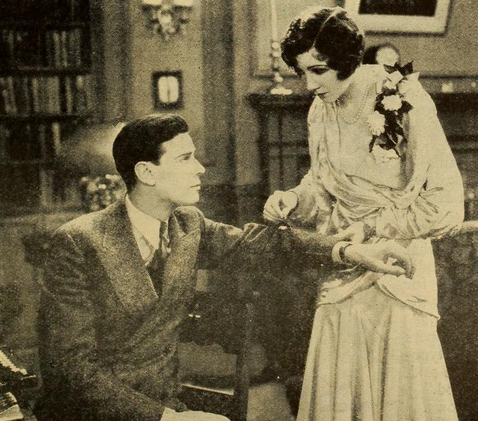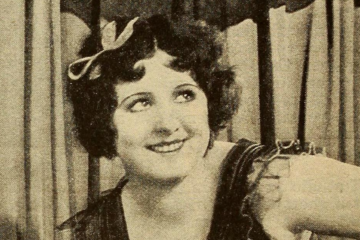Like
Starring: Claudette Colbert, Norman Foster, Ginger Rogers, and Charlie Ruggles
Directed by: Monta Bell
Released by: Paramount Pictures
Runtime: 81 minutes
Release date: May 17, 1930
Availability
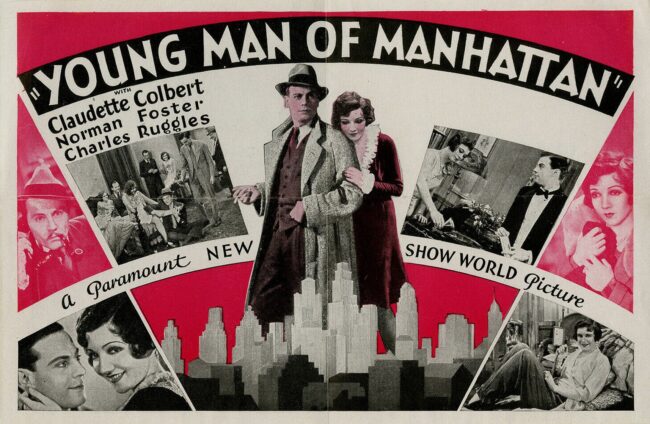
Young Man of Manhattan was produced by Monta Bell for Paramount Pictures. I believe, because of its availability, that it is likely in the public domain, but I make no promises. You can find it on YouTube and Archive.org.
Any streaming availability displayed via JustWatchProof That It’s Pre-Code
- In one of those ‘I can’t believe this slang is that old’ situations, Ginger Rogers is described as “a bit of penitentiary bait”.
- Anne and Toby have a ‘modern marriage’ where they’re allowed to go out with other people as long as they’re honest with one another about it.
- Anne is a successful and popular magazine writer, moreso than her husband.
- Booze from bootleggers and illegal liquor figure heavily into the plot.
Young Man: What Do You Want to Be?
“So you’re married?”
“Not just that, I’m in love!”
Look, I spent way too much time on the research portion of the review this week, so let’s get through our “it’s fine, I liked it” portion and get on to the meaty stuff, okay?
Anne Barnes (Colbert) is a movie critic and columnist who one rainy night gets into a cab with sports writer Toby McLean (Foster). They become quickly smitten and wed almost immediately, which, somehow, leads to problems. He has aspirations to move beyond sports writing and make Anne a housewife. Anne, on the other hand, is far more successful, getting a magazine contract that keeps her out and away from home and a publisher (Leslie Knowles) who is sniffing around to see if any cracks are forming in the marriage.
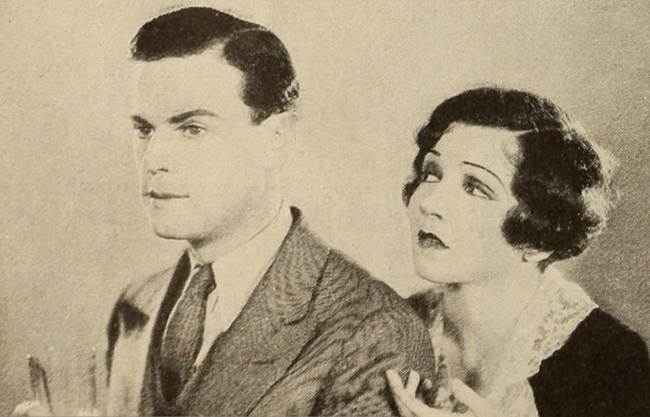
Complications grow when McLean meets Puff Randolph (Rogers), a squeaky debutante. At first Toby is interested in her as a possible legitimate story of youth running wild, but Anne inadvertently steals the story and title from him. He then opts to go out on the town with Puff, complete with a growing pile of cigarette butts on a bedside table, driving a wedge between the couple and their previously relaxed marital state. Toby’s colleague and pal, Shorty (Charlie Ruggles), attempts to smooth things out, but things grow tense and Toby’s drinking goes out of control. When Ann, briefly returning home, decides to indulge in some of his alcohol, she accidentally taps into one of his bootlegged bottles that renders her blind. Toby has to rally himself to save his wife’s sight and his marriage.
Film-wise, Young Man of Manhattan is part of the cycle clearly coming off the (at least ideological) heels of The Divorcee, where the importance of fidelity to marriage is questioned. Is the moral that cheating on your spouse, even with explicit permission, going to lead to disaster?
Sure. But.
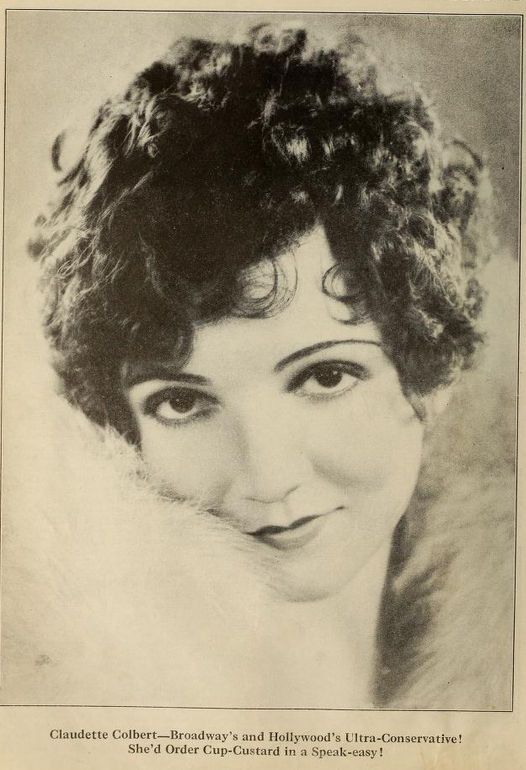
Here, the infidelities seem less-than-pleasurable, more of a ‘might as well’ affair than anything else. The nice part of Young Man is that it does add the professional dimension to things; we’re in the 1930s, a world where a hardworking woman could be a great success. Open bedroom doors are okay when the man is bestowing this freedom upon his wife; what happens when his wife is making more money and now having better sex than the husband?
Despondency, apparently, but at least Toby manages to get his shit together when needed. Stories like this are probably even more relevant nowadays with the widening gender gap in pay and education. Updating this movie, would we be treated to a rudderless Toby joining the ‘manosphere’? God forbid, not while he can still pull together such a dapper suit.
Ginger Rogers gets her first screen appearance here as “Puff” and even has a pair of fine musical numbers. (It was 1930, just roll with it.) She’s playing heavily into type with a squeaky voice but has lots of comedic charm. She works hard to stand in stark contrast to Colbert’s more studious but intelligent character, and it’s easy to see how this could be the start of big things for her. Charlie Ruggles, meanwhile, does his usual thing and adds a nice presence to the film.
With the crudeness of the currently circulating print and sound design, Young Man is poorly served in its current state and could shine with a great remastering. As it is, for people down far enough in the rabbit hole on this pre-Code business, this one has some nice surprises and forward-thinking ideas and excellent performances to check in on.
Trivia, Links, and More
- Based on the novel by Katherine Brush. Brush was one of the most prolific writers of the early 1930s and also wrote the novel on which the movie Red-Headed Woman was based.
- Apparently Ginger Rogers’ line in the film, “Cigarette me, big boy!” became a popular saying for a time. I mean, I guess you can still say it if you want.
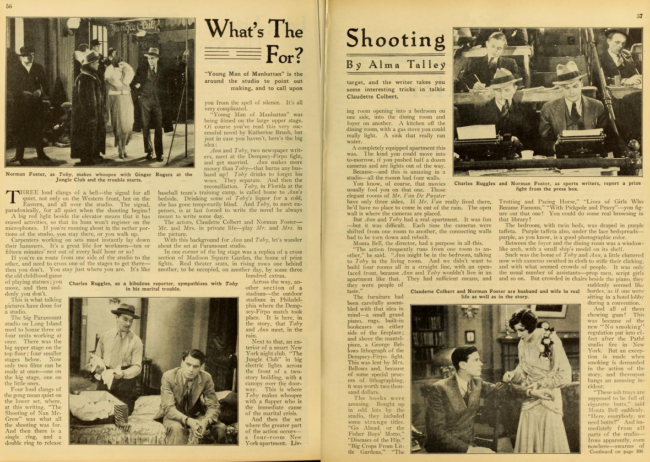
- There’s a fascinating article in Picture Play, “What’s the Shooting For?” by Alma Talley, about this film’s production at Paramount’s New York Astoria Studios and the filming needs of ‘talkies’. I enjoyed the side bar about the books on the shelves on set, which were a mishmash of titles that probably sound as nutty back then as they do today. Side fun fact, the film being shot at the same time as this in Astoria was Dangerous Nan McGrew, which I coincidentally covered a few weeks ago.
- Much of the sports footage in the film is reused, notably the opening boxing match of the famous Luis Firpo and Jack Dempsey fight. As per the previously mentioned article, Toby and Anne’s apartment had a lithograph of that fight framed in it, on loan from George Bellows’ wife, and worth around $2,000.
- Just taking a moment to appreciate this “Screenland” puff piece of Charlie Ruggles; the captain’s hat/pipe/knit sweater/tiny shorts combo is amazing, and I wish I could pull it off.

- Stars Claudette Colbert and Norman Foster were married at the time of filming, having met while working together on stage in The Barker. This is the only film the two would star in together, and they would divorce in 1935. There are always two reasons I’ve seen listed for the split (most notably expounded upon in Claudette Colbert: An Illustrated Biography by Lawrence J. Quirk): first, her closeness to her family drove a wedge between the couple. (In fact, Colbert remained living in her own, separate home with her mother throughout the marriage.) Second, Colbert’s screen career grew more successful than Foster’s and that caused problems, though I will admit I find this one slightly suspect, if only because that situation is the exact plot to this movie.
- For more details, this Vanity Fair profile from 2000, “A Perfect Star” by Amy Fine Collins, on Colbert recounts the end or possible ending of the marriage. (I highly recommend you read the full article for other fun details, like how Colbert was in Austria when the Nazis invaded or her recounting of the size of Clark Gable’s cock.)

- Other links:
Sidebar
One of those things that happens when people write about films or film history is that we find… things. Weird things. That just kind of pop out. For example, for Young Man of Manhattan, I wanted to learn more about Colbert’s marriage to Foster, so I went to her Wikipedia page. (Look, I didn’t want to know a ton more about their marriage, just the dates and circumstances.) While there, I found this line about Young Man of Manhattan:

Now, that seems weird, right? I watched this movie, and Norman Foster is fine; in fact, I kind of like him as a lead. He’s no Conrad Nagel, but who is. But putting this kind of objective aside into a Wikipedia article immediately raises alarms for me.
First, let’s make sure I’m not crazy. Here’s the New York Times’ unsigned review:
Norman Foster, as Toby McLean, the leading character of “Young Man of Manhattan,” gives an honest and restrained interpretation of a sports writer for a metropolitan daily newspaper in the film at the Paramount. […] Mr. Foster emerges from these as an unaffected, genuine player whose naturalness before the cameras make his an outstanding performance.Claudette Colbert, in comparison with Mr. Foster’s easy playing, is given, sometimes, to overacting.
[The picture finds] a leading man of singular earnestness and charm in Norman Foster.
I looked through a few other reviews from the time, too, and found nothing but nice things about Foster, and in fact, saw more citing Colbert’s stiffness than anything. So why is the Wikipedia page for Claudette Colbert crapping on Norman Foster?
The source for the [13] there is The Great Movie Stars: The Golden Years by David Shipman; click that link and you can borrow the 1989 book from Archive.org. It’s one of those nostalgic movie books from the 1980s that’s fine enough. Shipman’s exact quote reads:
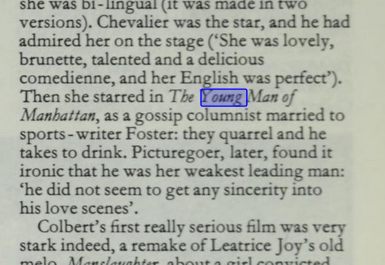
Okay, so Shipman pulled this quote from “Picturegoer”, a weekly British film magazine that ran from the 1930s to 1960s. The reason you don’t see it mentioned on my site much is that it’s not available via Lantern, only The British Newspaper Archive which is a paid subscription service.
But you do get three free articles when you sign up for the service, so of course I registered to see the original context for this quote. It comes from an August 1931 roundup column (more than a year after Young Man‘s release) that’s about Colbert’s chemistry with Maurice Chevalier coming after her starring role in The Smiling Lieutenant:
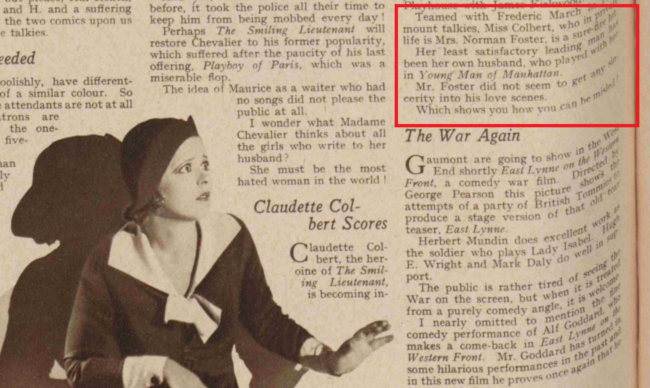
So let’s circle back to the original Wikipedia sentence: Foster “received negative reviews as one of her weakest leading men.” Neither Shipman nor the “Picturegoer” are technically reviews. Shipman cites “Picturegoer”, which clearly indicates what source he’s referring to, so it’s not even plural ‘reviews’ if you’re being pedantic. (Which I clearly am.) Next, the “Picturegoer” column is from 1931, one year after the movie was made, so the Wikipedia listing generalizing Foster as ‘one of her weakest leading men’ is from a source barely a handful of years into her motion picture career.
Why did I spend an hour of my life digging into this? I think I just found the sentence on Wikipedia annoying. I love Claudette Colbert, please don’t get me wrong, but Wikipedia articles are written and edited by people with agendas, as silly and pointless as it is to be slighting a leading man who me and probably 10 other people even remember. But that line’s purpose is to denigrate Foster as Colbert’s husband; he was weak.
And don’t get me wrong, I’m sure you could do so. But why? [deep exhale] Because someone who is editing her article really, really buys into the belief that Claudette Colbert is a lesbian but can’t come out and say so. Look, I’m not here to get into whether or not she was a lesbian, god knows that’s one of the great questions of our time. But there are accusations and no rebuttals, nothing from Collins’ story above that the Wikipedia draws heavily from that discusses that aspect of the story.
The Wikipedia article is left open-ended because that is the nature of collaborative fact-gathering. If you can’t prove a negative, then we can at least crap on the positive. So, in summation, always be wary of Wikipedia, *cough* even if it is a refreshing outlier in today’s fascist-centric online commercialized AI-slop news infrastructure. Two things can sometimes be true.
What is Pre-Code?
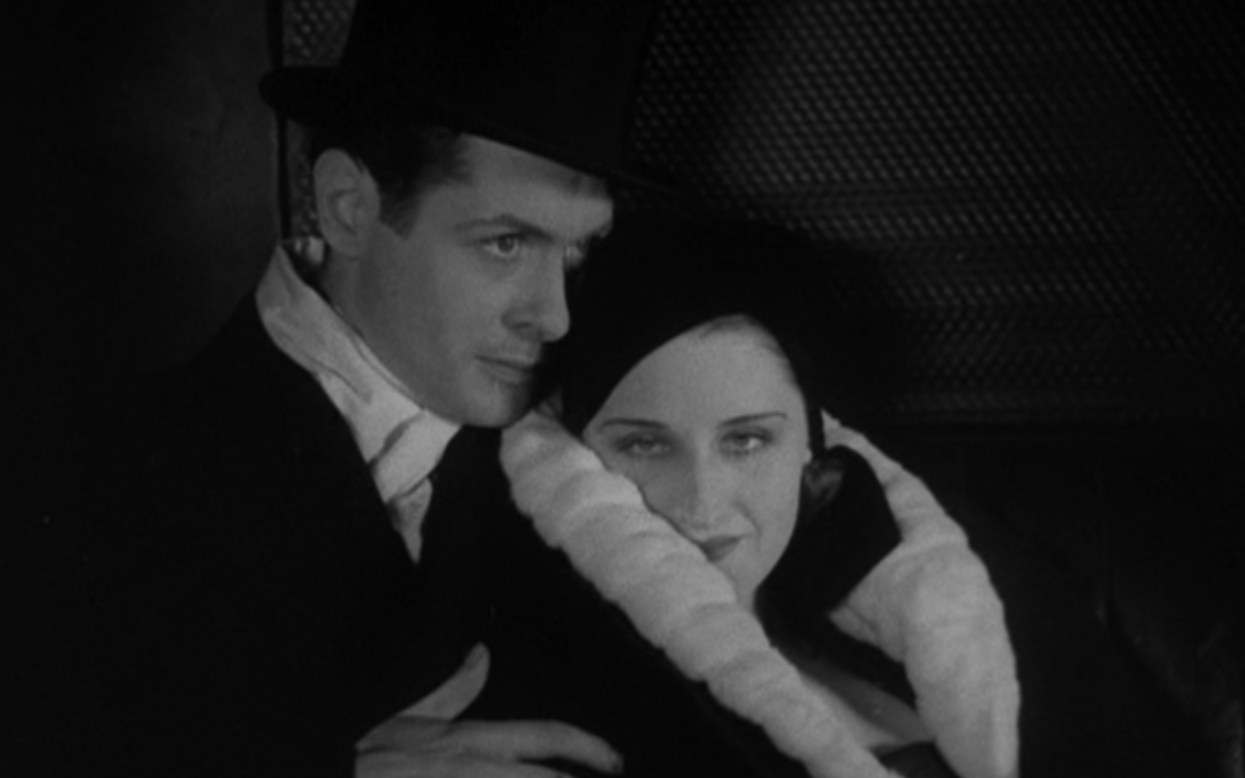
Click to learn more about pre-Code Hollywood, 1930-4, when movies were sexy, smart and sophisticated.
Index of Film Reviews
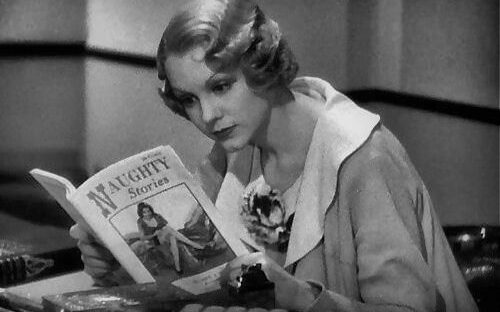
Browse all of the movie reviews on the site as well as schedules and pages that detail the world of pre-Code.
Explore the Pre-Code Era
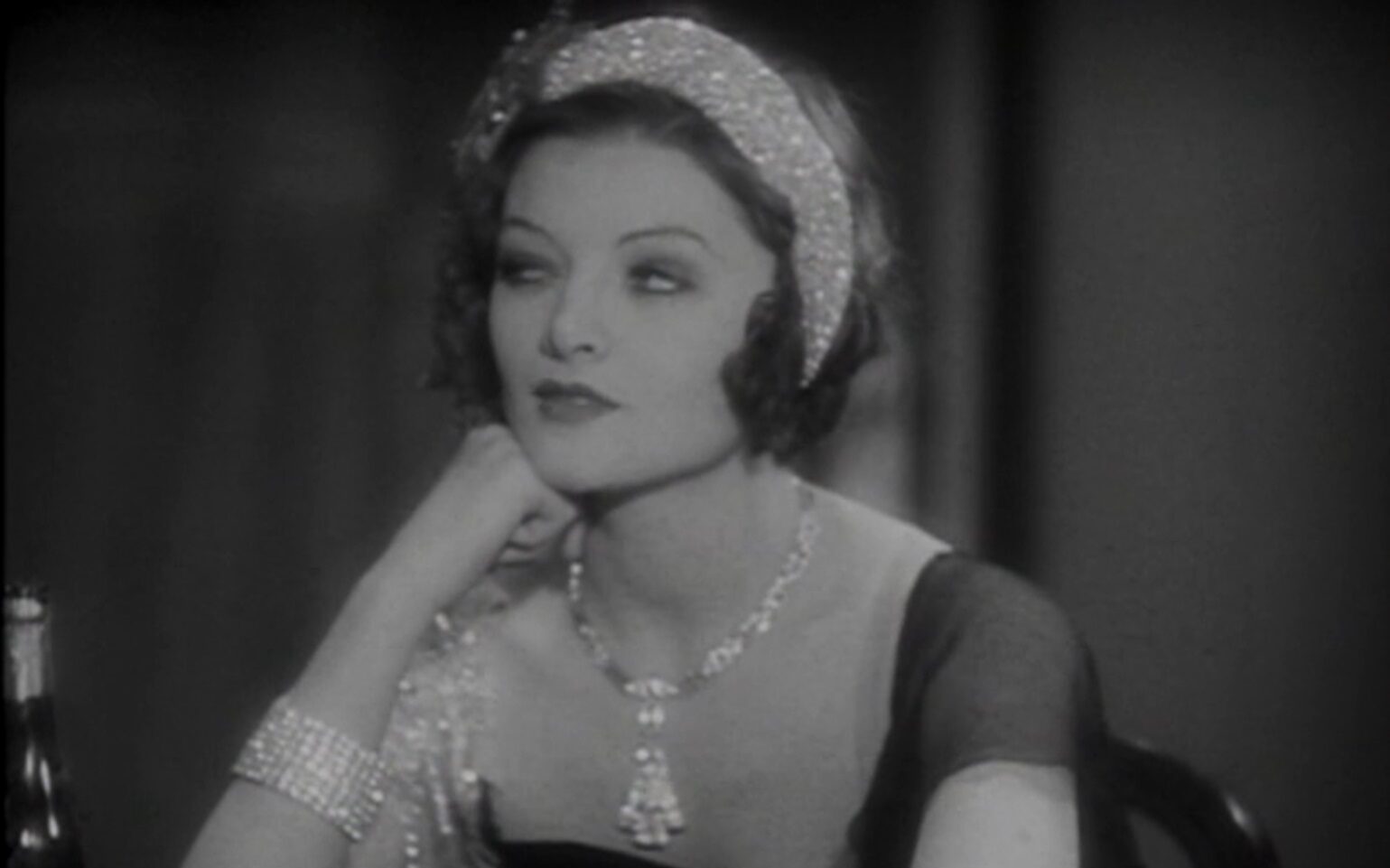
Dig through the pre-Code era through its highlights, its biggest hits, its essential films, and more.
